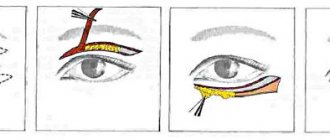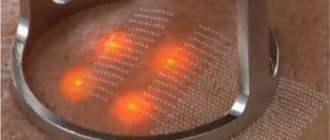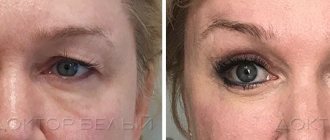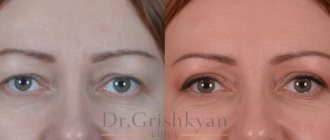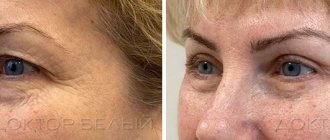One of the most common rejuvenation methods in plastic surgery is blepharoplasty. It allows you to correct many appearance flaws associated with both age-related changes and certain physiological characteristics.
Eyelid surgery is one of the most complex types of facial surgery. Not only the aesthetic effect that you get after recovery, but also many functional features depends on the qualifications of the surgeon. After all, the eyes, in the area around which the surgeon works, are a complex, delicate and very sensitive organ.
There are many myths regarding blepharoplasty, and patients who decide on the need for such an intervention, as a rule, do not go to the surgeon for their first consultation, but to the Internet, where they get information about all sorts of dangers that the operation poses. Our clinic specialists provide qualified answers to your questions.
Causes of possible complications of blepharoplasty
Undesirable consequences after eyelid surgery occur for the following reasons:
- Technical errors during surgery. Complications after eyelid blepharoplasty most often occur if eyelid correction is performed by a young specialist or a doctor who does not have sufficient experience in this area;
- Failure to comply with the surgeon’s recommendations by the patient during preparation for surgery and after it;
- Individual characteristics of the body. Complications may result from the skin’s tendency to form scars, unexpected allergic reactions, or changes in the course of the operation due to the abnormal arrangement of the patient’s blood vessels.
With any operation there are also so-called general surgical risks. They are associated with trauma to the skin, and in the area around the eyes it is the thinnest and most sensitive, which increases the likelihood of complications.
Table of development of complications depending on time
| Type of complication | Time of appearance after surgery | Most likely complications | Consequences |
| Early | Occur during surgery, several hours or days after it is performed | Swelling, bruising, infection | Easily removable, do not affect the outcome of blepharoplasty |
| Late | May appear after several weeks, sometimes months | Blepharoptosis, suture dehiscence, aesthetic defects | Corrective surgery most often required |
Regardless of the type of complication and the timing of its occurrence, the operating surgeon should be informed of disturbing changes immediately.
Should I be afraid of noticeable scars after blepharoplasty?
Scars remain after any surgery. Blepharoplasty is no exception. But for others, these scars will be completely invisible, because:
- firstly, they are done in areas that are located in the natural fold of the eyelid,
- secondly, the scars are very thin, since modern suture material is used for processing,
- thirdly, if you properly care for the operated area, no complications can be expected.
True, in some cases the individual characteristics of the skin are such that the stitch marks are slightly lighter than the main skin tone.
Lower blepharoplasty is often done using a transconjunctival method through a mini-incision on the inside of the eyelid using a laser. In this case, there will be no scar at all.
Types of early complications
Early complications of upper eyelid blepharoplasty most often arise due to damage to blood vessels, trauma to sensitive skin, and failure to follow the surgeon’s recommendations before preparing for plastic surgery and immediately after it.
Swelling
Swelling after surgery is considered normal, but only if it persists for the first few days after blepharoplasty. The cause of swelling is minor damage to blood vessels, which causes excess fluid to leak into the surrounding tissue. With simultaneous blepharoplasty of the lower and upper eyelids, swelling can spread in a circle and completely prevent you from opening your eyes for the first 2-3 days. Swelling that persists for a long time often causes headaches, blurred vision and double vision. Limiting fluid intake in the first days after surgery, adequate rest, and sleeping on a low pillow can help reduce the likelihood of severe swelling.
Hematomas
The main cause of hemorrhages in the upper eyelids after blepharoplasty is vascular damage. Hematomas appear either immediately or 2-3 days after plastic surgery. Depending on the extent of the damage, they are divided into:
- Subcutaneous. Blood accumulates at the incision site under the skin. This type of hemorrhage is not dangerous; the bruise resolves in 1-2 weeks. Palpation and the use of ointments for hematomas approved by the surgeon help speed up this process. But in some cases, the doctor may recommend opening the edges of the wound and removing accumulated blood;
- Tense. They differ from subcutaneous ones by the accumulation of blood in a large volume. Treatment consists of opening the postoperative wound, pumping out the blood and suturing the damaged capillaries;
- Retrobulbar . The cause of hemorrhage is damage to large vessels located behind the eyeball. With minor blepharoplasty, it rarely occurs. Signs of a retrobulbar hematoma are protrusion of the eye, limitation of its mobility, severe pain, impaired visual function, hematoma under the eye or on the upper eyelid, redness of the conjunctiva. If such symptoms appear, you should immediately contact the operating surgeon or ophthalmologist; untimely treatment of retrobulbar hematomas leads to temporary loss of vision, in severe cases to retinal thrombosis and acute glaucoma.
Ectropion
The term ectropion refers to the inversion of the lower eyelid. The defect occurs due to the removal of too much tissue during the procedure and is a complication of lower eyelid blepharoplasty. Ectropion not only worsens appearance, but also increases dryness of the mucous membranes, which in turn predisposes to the development of ophthalmic diseases. The complication is eliminated conservatively or surgically. If the defect is not severe, the doctor first recommends doing special massage and gymnastics for the eyes. If they are ineffective, surgical intervention is recommended, consisting of the application of supporting sutures.
Increased lacrimation
A common complication of transconjunctival blepharoplasty is increased lacrimation. In most cases it is explained by severe swelling in the postoperative period. But if lacrimation continues to bother you even after the swelling subsides, then other reasons for its occurrence should be considered. This may be scarring, leading to narrowing of the tubules or displacement of the lacrimal openings. To eliminate lacrimation, probing of the lacrimal canaliculi and sometimes excision of scar tissue are used.
Infection
Pathogenic microorganisms may enter the wound both during and after surgery. Signs of infection are increased redness of the suture area and around it, increased local temperature, increased swelling, and painful sensations. At an early stage, secondary infection can be successfully treated with antibiotics; in advanced cases, cutting the suture may be necessary to clean the wound from the inside.
Seam divergence
The reasons for this complication after blepharoplasty surgery are non-compliance with the technique of suturing the wound, severe swelling, and inflammation due to infection. If the condition of the suture is of concern, you should consult with the surgeon who performed the blepharoplasty.
When the sutures come apart, the likelihood of infection of the injured skin, opening of the wound and the formation of rough scars increases.
Diplopia
Diplopia is double vision that occurs as a result of injury to the eye muscle during surgery. It does not pose any particular danger, since in about 2-3 weeks the muscle recovers on its own and normal vision returns. However, a patient with diplopia should be observed by an ophthalmologist; if the problem persists, the integrity of the muscles is restored through surgery.
Types of blepharoplasty
Plastic surgery is performed after a preliminary consultation with a surgeon, who evaluates not only the patient’s wishes, but also the actual condition of the eyelids. It is necessary to explain to the patient that some types of blepharoplasty leave scars that are barely noticeable, and you should be prepared for this.
Only a doctor can decide what type of blepharoplasty is possible in a particular case:
- Lower eyelid surgery – this operation allows you to eliminate sagging and sagging skin. It is also possible to hide excessively prominent tear troughs. Surgical correction of this type is prescribed for the prominent transition between the lower eyelid and cheek. The incision is made along the eyelash line, so after the end of the rehabilitation period and complete healing, traces of the intervention are almost invisible.
- Upper eyelid surgery – indications are hernias, which serve as a weighting material, causing the eyelid to droop. The incision is made from the outside in an area of the skin, which is subsequently hidden in a natural fold, so a trace of the intervention remains, but it is practically invisible.
- Circular eyelid surgery – the intervention includes work on the upper and lower eyelids. This operation turns out to be the most often chosen by plastic surgeons, because with its help it is possible to achieve the most complete and holistic result.
- Transconjunctival blepharoplasty - allows you to solve external problems by removing fatty tissues and hernias through special punctures on the mucous membrane. No scars remain as a result of the operation, since the skin is not affected, and the mucous membrane heals much faster and without consequences.
- Redistribution of fat areas - the indication for this type of intervention is the obvious asymmetry of the facial area around the eyes. Accordingly, on one side, areas of fat are eliminated with further transplantation to the opposite side.
- Canthoplasty is a method that allows you to change the natural shape of the eyes. Thanks to this operation, it is possible to create the effect of Asian eyes.
- Canthopexy is used to lift the outer corners of the eyes and then fix them in place.
Blepharoplasty is performed in three ways:
- The classic version - the incision is made on the outside using a scalpel.
- Transconjunctival option - instead of an incision, a puncture is made from the mucous membrane of the eye.
- Mixed option - when both types of surgical intervention are used during the operation.
Contraindications to blepharoplasty
Plastic surgery can solve a lot of cosmetic problems, but there are also contraindications:
- The presence of inflammatory and other pathological conditions in the eye area.
- Diabetes.
- Oncology.
- Systemic blood diseases.
- Pregnancy period.
- Menstruation in women.
- The presence of inflammatory diseases in the body.
- Increased intracranial or intraocular pressure.
- Arterial hypertension.
- Irritable eye syndrome (“dry computer syndrome”).
If it is possible to eliminate one of the contraindication factors, then after the end of the rehabilitation period you can begin examination and preparation for surgery.
Preparing for blepharoplasty
Before the operation, a standard medical examination is carried out. The following rules and recommendations must also be observed:
- A few days in advance, you should stop using cosmetics that may affect your skin condition.
- Sunbathing is prohibited two months before surgery.
- The day before surgery, you should avoid all types of physical activity, as this may cause a rush of blood to the head, and this may cause bleeding during the operation or negatively affect the rehabilitation period.
- Alcohol intake should be avoided for 2 weeks before surgery and during the recovery period.
- Simple carbohydrates, sugar, and carbonated drinks should be completely excluded from the diet.
Types of late complications
Late complications after blepharoplasty become noticeable at the end of the rehabilitation period. That is, from 3-4 weeks to 3-4 months after surgery. They most often occur due to the low qualifications of the plastic surgeon, although some undesirable consequences are also explained by the individual characteristics of the body.
Blepharoptosis
The term blepharoptosis refers to a pathological drooping of the upper eyelid that prevents the eye from opening completely. The eyelid seems to hang over the eye, covering most of it. The appearance of blepharoptosis with swelling is considered a normal variant. You should consult a doctor if the defect persists even after the swelling subsides. In this case, the cause of blepharoptosis may be damage to muscle fibers and ligaments during blepharoplasty. To correct true ptosis, repeat surgery is necessary.
Lagophthalmos
With lagophthalmos, the process of normal closure of the eyelids is disrupted. You can clearly see what this complication of blepharoplasty is in the photo. The cause of the defect is excessive skin removal during surgery. Lagophthalmos often occurs if repeated blepharoplasty is performed too quickly after the first. With lagophthalmos, the process of natural hydration of the cornea is disrupted, as a result it loses transparency and ultimately this can lead to blindness. Therefore, if the eye does not close completely, repeated surgery is extremely necessary.
Cyst
A cyst is a neoplasm separated from healthy tissue by a capsule. Most often during blepharoplasty it forms near the seam. Treatment consists of surgical removal of the cyst; such an operation does not affect the result of blepharoplasty and therefore the cyst can be considered a minor complication.
Hyperpigmentation
The appearance of dark spots on the eyelids and under the eyes occurs after the resorption of severe hemorrhages. When blood decomposes, dark-colored decay products accumulate in the subcutaneous layers; they do not always leave the body naturally and over time can appear in the form of dark spots on the skin. Treatment mainly involves the use of absorbable ointments and lotions.
Formation of rough (keloid) scars
Normally, within 3-5 months, postoperative scars on the eyelids after blepharoplasty soften and resolve. That is, they should remain practically invisible. However, this does not always happen. There are several reasons for the formation of keloid scars:
- Seams coming apart;
- Incorrect suturing;
- Individual characteristics of the body.
If, during preparation for surgery, the patient shows a tendency to form rough scar tissue, then during the blepharoplasty itself, the surgeon must introduce drugs into the incision area that promote gentle tissue healing. If you already have scars from plastic surgery, their severity can be reduced using mesotherapy, laser resurfacing, and fractional thermolysis.
Eye asymmetry
The reasons for complications of upper eyelid blepharoplasty in the form of eye asymmetry are associated with improper sutures and disruption of the tissue scarring process. A complication may also be a consequence of the surgeon’s inattention to patients with existing congenital asymmetry of the eyes, which leads to an increase in the acquired or congenital defect.
Keratoconjunctivitis
With almost any ophthalmic eye surgery, keratoconjunctivitis sicca develops over time. This also applies to blepharoplasty.
However, “dry eye syndrome” is one of the easiest consequences of plastic surgery to eliminate.
Instilling eye drops, similar in composition to tears, completely solves the problem.
What's so difficult about a simple eyelid lift?
The anatomy of the eyelids is very complex, since the eyelids belong to the appendage apparatus of the eyeball and carry an important functional load - there are a lot of subtle anatomical structures, many features that require understanding and knowledge of various correction techniques. I'm not even talking about the fact that each patient's eyelids are different and the shape of the eyes can be specific. There may be ethnic characteristics (for example, plastic surgery of Asian eyelids is a rather specific operation), as well as age and non-standard structure from birth. Suppose you decide to save money and choose a young surgeon. As long as everything goes “as planned”, it’s not so bad. Well, it didn’t turn out as well as you expected, well, the shape of the eyes became rounded (a typical complication with blepharoplasty of the upper eyelids - “fish eyes”) or some kind of “pump” formed on the scar. Your young doctor may say that everything undesirable will go away on its own over time, or maybe not...
But blepharoplasty of the upper eyelids is still a relatively predictable operation; with the lower eyelids everything is much more complicated and there is an order of magnitude greater risk. The patient's dissatisfaction with changes in the shape of the eyes or some not too noticeable aesthetic shortcomings of plastic surgery is not so terrible - in the end, it is easy to redo it. It is worse if a serious complication occurs after blepharoplasty. In this case, real panic often begins, not only in the patient, but (which is much worse) also in the inexperienced surgeon. Who should I run to?! In such desperate cases, they call me and my most respected colleagues - experienced plastic surgeons. To be honest, we all really dislike such calls. On the one hand, a person is in trouble, a young colleague is terrified and confused - it is very difficult to refuse. On the other hand, complications are sometimes very serious, including infection of the orbit and loss of vision. In such cases, you have to think about how much you can help (after all, this is not always 100% possible!) and about the enormous professional responsibility that you take on instead of a young surgeon.
An eyelid lift is indeed a very effective and not at all difficult operation for the patient if everything is done professionally. However, unsuccessful blepharoplasty can become a problem, the solution of which will require a lot of patience, strength and nerves. I'm not even talking about money...
Prevention of complications
It is quite possible to reduce the risk of most complications after blepharoplasty. To do this you need:
- Choose a reliable clinic equipped with the most modern equipment;
- Find a qualified surgeon with the appropriate certificates and sufficient experience in the field of eye plastic surgery;
- Make sure that the clinic follows all the rules of asepsis and antisepsis;
- Get advice from an ophthalmologist. The doctor will evaluate the eye conditions, determine the likelihood of complications and give his recommendations;
- Undergo a complete diagnosis, based on the results of which it will be possible to conclude whether blepharoplasty is possible or whether this plastic surgery is contraindicated for you;
- Follow all recommendations of the specialist during the preparation period and during recovery after the procedure.
If any alarming changes in well-being appear after blepharoplasty, you should consult a doctor - timely therapy prevents the progression of the resulting disorders.
Complications and contraindications for surgery
Surgery will be prohibited if the patient has the following pathologies:
- diseases of the cardiovascular system;
- diabetes mellitus of any type;
- retinal detachment;
- pathologies of the thyroid gland that cause hormonal imbalance;
- high blood pressure accompanied by crises;
- dry eye syndrome
The negative consequence of this operation is that the inversion cannot be completely removed. There may be a small distance between the eyeball and the edge of the eyelid. There is a small chance of the eyelid turning inwards. Other side effects of the procedure include:
- disruption of the lacrimal gland;
- bleeding in the first days after correction;
- formation of skin cysts;
- the appearance of lagophthalmos and blepharoptosis;
- infection, formation of an inflammatory process;
- seam divergence;
- formation of rough scars in the eyelid area
In order to reduce the formation of complications to zero, you must follow all the recommendations of the treating doctor. During the rehabilitation period it is recommended:
- minimize physical activity, stop bending sharply for a month. This promotes rapid tissue healing and swelling;
- do not visit the swimming pool, bathhouse, sauna;
- Do not be exposed to direct sunlight for six months after the operation. This will help avoid the formation of age spots.
Remember that a positive outcome of the operation depends not only on the correct actions of the plastic surgeon, but also on compliance with all recommendations during the rehabilitation period.
Reviews about the consequences and complications after blepharoplasty
Margarita, 42 years old “I had blepharoplasty of the upper eyelids 2 years ago - I wanted to remove the hanging skin. The operation was generally successful, but it took a long time for the bruises to go away and the stitches to itch. For several weeks after the plastic surgery I had to resort to moisturizing drops in my eyes, since without them I felt severe dryness and pain.” Galina, 39 years old “My eyelid correction was unsuccessful. Almost immediately I noticed unpleasant consequences - one eye began to differ in shape from the other. The doctor assured that this was a temporary phenomenon and in 3-4 months everything would return to normal. This did not happen, the clinic does not want to admit the problem, so I have to use a ton of cosmetics to hide the defect. I’m trying to save money for repeat blepharoplasty, but I don’t know if I’ll dare to do it, I’m already scared that I’ll run into an incompetent surgeon again” -
Rehabilitation period
In the first 2-3 days after surgery, severe swelling and bruising are observed. But do not be upset, as this is an absolutely normal phenomenon. The unpleasant consequences disappear within 2-3 weeks. During this period, you should not sunbathe, play sports, strain your eyesight, watch TV, or sit at the computer for a long time. Maximum rest is the key to accelerated rehabilitation without risks or complications.
Complications
There are early and late complications of blepharoplasty. Early complications are corrected or go away on their own, and are expressed in the form of hematomas, bleeding, protrusion of the eyeball.
Late complications are much more difficult to eliminate, and such conditions include cysts, suture dehiscence, tearing and pathological reaction to light, and drooping eyelids. Correction and restoration are carried out strictly under the supervision of a doctor.
Recovery period after blepharoplasty
I believe that my main task as a plastic surgeon is to warn my patients about all the possible consequences of plastic surgery so that they can make an informed and mature decision, and so that the consequences of this operation do not frighten them or become an unpleasant surprise for them. Today I will talk about the postoperative recovery period after blepharoplasty.
I give each of my patients a memo to sign, which clearly states all possible manifestations in the postoperative period and the possible consequences of the operation. This does not mean that all these consequences must necessarily occur in every patient , and this reminder is not made at all to intimidate you. On the contrary, it is primarily needed so that everyone who decides to undergo blepharoplasty knows what manifestations are within the normal range and is not afraid of them, and for what reasons it is better to be wary and consult a doctor. In each specific case, only some of the symptoms described below may appear - it is not at all necessary that the whole “bouquet” awaits you at once. Therefore, carefully read this memo, and do not worry if everything goes within normal limits. However, if something causes you anxiety or discomfort, be sure to consult a doctor. My consultation costs 1000 rubles, and I provide postoperative examinations for free.
So, the patient’s memo “After blepharoplasty”
Bruising and swelling will increase for 3 days after surgery . This does not add to your attractiveness, so be prepared for the fact that for several days after eyelid surgery you will look unpresentable, and if possible, cancel official business during this time. The bulk of the swelling and bruising will go away by 3-4 weeks, and the swelling will finally subside 4-6 months after surgery. In rare cases, some swelling may persist for up to a year.
Bruises may appear immediately after surgery , or they may appear only after a few days - it depends on the individual characteristics of your body.
Also, the postoperative period may be accompanied by such manifestations as:
- discomfort in the eyes (stinging, pain, etc.);
- temporary visual impairment;
- conjunctivitis may develop;
- chemosis - swelling of the conjunctiva of the eyeball (popularly known as “jelly”);
- ecchymosis - hemorrhages in the skin or mucous membrane;
- increased lacrimation;
- dry eye syndrome;
- hematoma – accumulation of liquid or coagulated blood in the area of the operated eyelids;
- 2-3 weeks after surgery, the scar may tighten and thicken, which can lead to rounding of the eye, as the edge of the lower eyelid is pulled back, and in rare cases, to eversion of the lower eyelid, which is associated with the formation of a scar;
- redness of scars;
- After surgery on the upper eyelids, the eyes may not close completely at first due to swelling.
All of the above phenomena can appear and persist for up to 3-4 months , in rare cases – up to six months. Bruising and swelling may be asymmetrical - on one side the bruises may be larger, on the other - smaller. Rehabilitation can take a long period of time, so in order to completely restore the skin of the eyelids and see the results of the operation, you need to be patient and strictly follow the doctor’s recommendations .
In addition, it is extremely important to remember that the human face is inherently slightly asymmetrical , including the eyes. The two halves of the face of absolutely all people have subtle differences in shape, size and outline, so it should not be surprising that some asymmetry can be observed after surgery.
Blepharoplasty, examples of the work of plastic surgeon A.P. Panayetov:
Blepharoplasty, reviews of the work of plastic surgeon A.P. Panayetov:
If you still have questions, you can ask them in the “question-answer” section.
You can make an appointment for a consultation with plastic surgeon A.P. Panayetov in Moscow by phone (viber, whatsapp) or through the feedback form on the website:


